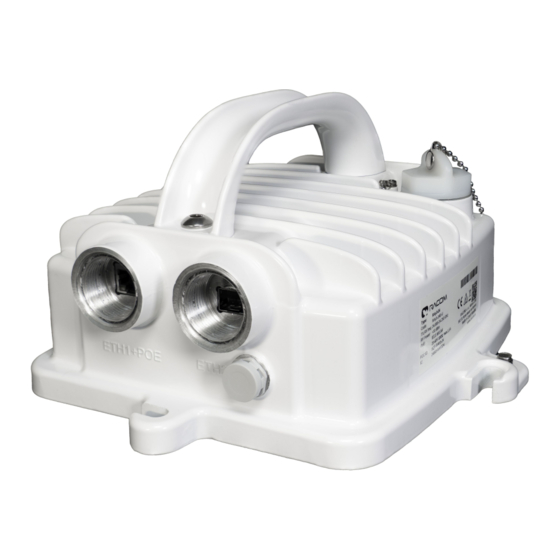
Table of Contents
Advertisement
Quick Links
Advertisement
Table of Contents

Summarization of Contents
1. Product
1.1. Main characteristics
Details supported license-free and licensed frequency bands, bandwidth, and modulation capabilities.
1.2. Mechanical interfaces
Describes the physical properties of RAy units for installation, including waveguide and grounding.
1.3. Ethernet + power interfaces
Details the Ethernet ports (ETH1+POE, ETH2) for data transfer and power sourcing.
1.4. Service interfaces
Covers the 'S' slot functionalities including USB, RSS output, HW button, and Status LED.
1.5. Status LED ( S )
Explains the meaning of the LED indicator's color combinations for unit status.
1.6. Sizes, packaging and labeling
Provides unit dimensions, weight, packaging details, and product label information.
1.7. Ordering codes
Details unique ordering codes, capacity keys, feature activation, and accessories.
3. Step-by-step Guide
3.1. Pre-installation check out
Guides users through initial setup and workplace arrangement before installation.
3.2. Service access
Explains how to access unit parameters for configuration and management.
3.3. Basic link configuration
Covers default radio parameters and initial link setup for optimal performance.
3.4. Link test
Details methods to verify radio link functionality and performance.
4. Installation
4.1. Line of sight test
Verifies unobstructed view between units before mast installation.
4.2. Antenna mounting
Describes antenna mounting procedures based on vendor and type.
4.3. RAy Unit mounting
Details the process of mounting the RAy unit to various antennas and mounting kits.
4.4. Connectors assembly and disassembly
Provides instructions for assembling and disassembling connectors with bushings.
4.5. Grounding and overvoltage protection
Explains site grounding and surge protection for installation resilience.
4.6. Power supply
Covers power supply options including PoE and DC, with detailed parameters.
4.7. Start up
Guides through the initial startup process, noise analysis, and antenna alignment.
5. Configuration
5.1. Introduction
Overview of configuration methods and supported web browsers.
5.2. Status bar
Describes the status bar and its fields for monitoring link and unit status.
5.3. Status
Provides detailed information on local and remote station status and parameters.
5.4. Link settings
Covers general, radio, service access, alarms, and switch settings for the link.
5.5. Switch settings
Details switch port status, RMON counters, RSTP, interface, QoS, and advanced settings.
5.6. Tools
Covers maintenance, live data, history, logs, and programs for unit management.
5.7. Help
Explains how to access embedded help for configuration parameters and CLI.
6. Command Line Interface
6.1. Connection via CLI
Guides on connecting to the unit via Telnet, PuTTY, or SSH.
6.2. Working with CLI
Details CLI options, parameters, and script examples.
6.3. Configuration with CLI
Explains configuration backup, restore, firmware upgrade, and remote authorization via CLI.
6.3.4. Radio loopback
Describes the radio loopback function for antenna CPI measurement.
7. RAy Tools app for Mobile devices
7.1. Menu options
Details calculation, alignment, configuration, and about functions of the mobile app.
7.2. Application availability
Specifies requirements and availability of RAy Tools for mobile OS.
7.3. Feedback to RACOM
Provides contact information for feedback and beta testing.
8. Troubleshooting
8.1. LED on powered unit does not shine
Guides on checking power supply and voltage for LED issues.
8.2. LED on powered unit shines other colors than just green
Explains LED color meanings and troubleshooting for non-green status.
8.3. Polarization incorrect
Details correct polarization for RAy3-17/24 and arrow indicators.
8.4. The link cannot be established
Troubleshooting steps for link establishment issues, including compatibility.
8.5. RSS and Antenna alignment
Guides on link configuration and RSS monitoring using various tools.
8.8. Access to the Local unit is blocked
Provides solutions for blocked local unit access, e.g., via HTTPS.
9. Technical parameters
9.1. RAy3-10 details
Provides detailed link speed and radio parameters for RAy3-10.
9.2. RAy3-11 details (preliminary)
Details link speed, radio parameters, sub-bands, and frequency tables for RAy3-11.
9.3. RAy3-17 details
Provides link speed, radio parameters, frequency limits, and tables for RAy3-17.
9.4. RAy3-18 details
Details link speed, radio parameters, sub-bands, and frequency tables for RAy3-18.
9.5. RAy3-24 details
Provides link speed, radio parameters, frequency limits, and tables for RAy3-24.
9.6. RAy3-80 details (preliminary)
Details link speed, radio parameters, frequency limits, and tables for RAy3-80.
10. Safety, regulations, warranty
10.1. Regulations
Specifies compliance with Telecommunications Authority rules and EIRP limits.
10.2. Safety distance
Provides minimum safety distances for 24 GHz based on antenna and power.
10.3. Professional installation
Emphasizes that installation and servicing must be done by trained personnel.
10.4. RoHS and WEEE compliance
Declares compliance with European directives for hazardous substances and waste.
10.5. RACOM Open Software License
Provides terms for the RACOM Open Software License.
10.6. Warranty
Details RACOM's warranty terms for supplied parts and equipment.
10.7. Declarations of Conformity
Contains EU Declarations of Conformity for RAy3-10, RAy3-17, and RAy3-24.
10.8. FCC and IC authorization
Lists FCC and IC compliance information for RAy3-24.
10.9. Country of Origin Declaration
Declares the country of origin for RAy microwave links and accessories.

Need help?
Do you have a question about the RAy3-80 and is the answer not in the manual?
Questions and answers